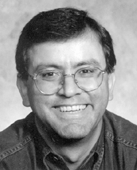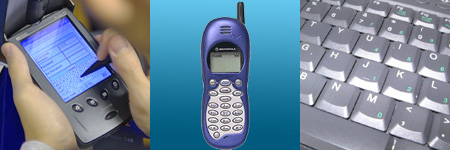The Power of "Pervasive"
|
6.4.03 - What does "pervasive" really mean? According to Ender Ayanoglu, the relatively new director of the UCI Center for Pervasive Communications and Computing, pervasive in the sense of communications means an emphatic "communications all the time everywhere." He elaborates by saying, "The communication devices we carry - laptops, pagers, cell phones, and PDAs - are going to converge as single devices. That's the industry trend. Major corporations, like Intel with Microsoft supporting the effort, are doing this. Furthermore, we're going to see convergence of communications and computing - especially via wearable devices that have connectivity to the telephone network and the Internet 24 hours a day."
This revolution is going to be nothing short of "life changing," but getting there properly will require lots of research, technical innovation, and close collaboration between academia and industry. That's where his center, a Calit² academic partner, comes in: The 30 affiliated faculty are conducting research in seven related areas covering the broad spectrum of electrical engineering, computer science, and communications broadly considered:
- communications algorithms
- networks
- computing systems
- circuits
- devices
- communications software
- security
The center is in the process of creating a "research inventory" with faculty members developing white papers in these technical areas to (1) organize their expertise, (2) attract corporate sponsors, and (3) secure federal funding. "We're modifying our membership structure," says Ayanoglu. "Current member companies are donors, but we're extending membership to include other organizations through research contracts and subscriptions," which he describes as fixed contributions by companies that in turn provide them access to students, early drafts of research reports, and campus libraries. Graduate students are increasing in number, and CPCC has openings for faculty positions and postdoctoral and graduate fellows. "One of our key goals," says Ayanoglu, "is to grow and work with Calit² as one of its most active centers."
Ayanoglu says that bringing industry experience into academic work is relatively new in his experience. "When I was a student, universities tended to be closed. But the vacuum left by the disappearance of many influential industrial R&D labs has led to a new model of inviting industry in to comment. It keeps academic research much more relevant to real life. But we also have to be careful of the danger of focusing on just short-term problems. That could cause us to miss the big opportunity that emerges from work on long-term problems. In fact, we need to direct research to both short- and long-term problems."
And, it should be pointed out that this give-and-take with industry works both ways. Industrial partner Conexant, for example, requested that specific faculty members visit their campus and spend a day with them making presentations and talking with individuals to seed collaborations. "Conexant is very interested in working with us," says Ayanoglu. "This type of interaction should work especially well in the flexible and creative context of Calit², which is helping generate intellectual property of benefit to the state."
|
CPCC also wants their industrial partners to benefit from the new Calit² buildings, slated for occupancy in both cases by early 2005. These buildings will be literal incarnations of the "living lab" concept where researchers can test proofs of concept and prototype new technologies and services. (See Web cams on both construction sites at the top of Calit²'s home page: www.calit2.net.)
CPCC is also attracting attention for its active seminar program, advertised on the Calit² Web site, and plans for workshops.
CPCC boasts some very highly regarded faculty members such as Hamid Jafarkhani, an associate professor in the Electrical Engineering and Computer Science department. Previously with Broadcom and ATT Labs, he is considered one of the inventors of space-time coding, which is one of the major breakthroughs in communications in the last 10 years. "This technique has already made its way into many communications standards," says Ayanoglu, "including in a number of next-generation wireless telephony standards." Jafarkhani has since improved on his original work and published papers on better codes. In addition, he's working on source coding techniques and communications networks.
Ayanoglu, as an extension of his work at Cisco before coming to UCI, specializes in wireless LANs, optical communications, computer networks, and multimedia. He took on the directorship of CPCC some six months ago. Prior to Cisco, he worked at the Communication Systems Research Laboratory of Bell Labs. His research covered many aspects of communications, such as transmission techniques, wireless, broadband, and optical networks. He is one of the inventors of 56K modems, and the two basic 56K modem patents currently owned by Agere Systems carry his name.
CPCC seeks to increase activity in communication in both breadth and depth. "We want to increase the number of researchers in areas we're already strong in and identify important areas that we don't yet have a presence in." Three areas targeted for expansion are communications algorithms, implementation (hardware and software), and communications networks.
CPCC was founded three years ago in a ceremony attended by Governor Gray Davis and the CEOs of the two companies that provided key funding: Dwight Decker, Conexant Systems, and Henry Samueli, Broadcom Corp. Their industrial support provides startup funding for five faculty and some grad fellowships. To date, some 24 entering graduate students have received full support (room, board, and tuition) for a year from this program. "All have been 'picked up' by research grants for continued support until they graduate, so we've shown this model works," says Ayanoglu.
For more information, see www.eng.uci.edu/cpcc.



